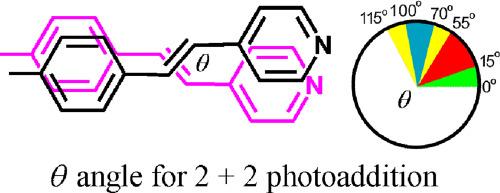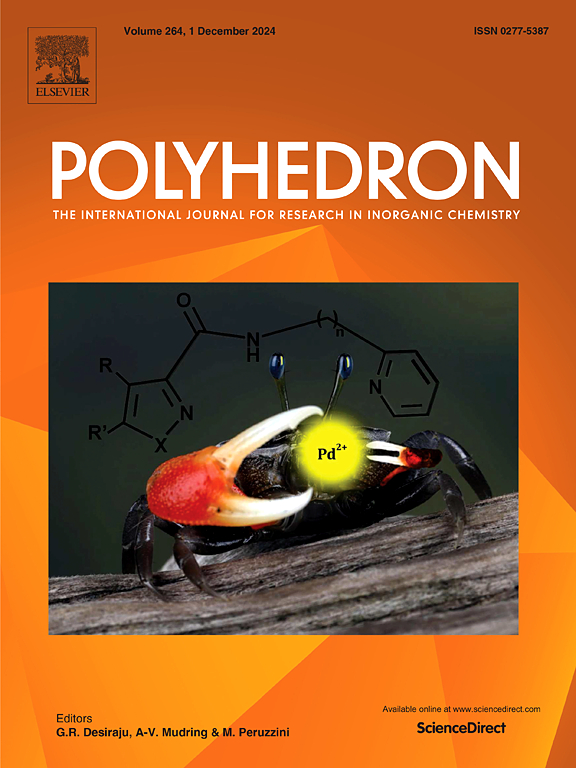Syntheses, structures, photophysical and photochemical research of a series of coordination polymer analogues: [M(pda)(bpeb)]n, (M = Zn, Ni and Co, pda = 1,4-phenylenediacrylate, bpeb = 1,4-bis[2-(4-pyridyl)ethenyl]benzene)
IF 2.6
3区 化学
Q2 CHEMISTRY, INORGANIC & NUCLEAR
引用次数: 0
Abstract
Three coordination polymers [M(pda)(bpeb)]n, 1, 2 and 3 (M = Zn, Ni and Co, bpeb = 1,4-bis[2-(4-pyridyl)ethenyl]benzene, and pda = 1,4-phenylenediacrylate) have been synthesized and characterized. Their structures have been carefully investigated. They are compact 8-fold interpenetrating three-dimensional diamondoid network structures. Photophysical and photochemical investigations have been carried out. The d and θ for the closest C![]() C bonds in 1–3 are: 3.714 Å, 35.62°; 4.007 Å, 47.92° and 3.865 Å, 40.817°, respectively. The distances conform to Schmidt's rule, but the angles deviate far from the 0° required by Schmidt's rule, yet they are less than the 70–100° range for structures that may potentially undergo photochemical reaction. Photochemical studies have confirmed that these compounds are inert to photochemical reactions. Photoaddition cannot occur because the θ angle between the C
C bonds in 1–3 are: 3.714 Å, 35.62°; 4.007 Å, 47.92° and 3.865 Å, 40.817°, respectively. The distances conform to Schmidt's rule, but the angles deviate far from the 0° required by Schmidt's rule, yet they are less than the 70–100° range for structures that may potentially undergo photochemical reaction. Photochemical studies have confirmed that these compounds are inert to photochemical reactions. Photoaddition cannot occur because the θ angle between the C![]() C double bonds is between 15 and 55°. An extended Schmidt's rule is proposed to consider the influence of the θ angle between 0 and 115° on the photoaddition: θ should be 0–15° for direct photoaddition; or 55–115° for photoaddition after photoisomerization; and θ = 15–55° is very unlikely to undergo photoaddition.
C double bonds is between 15 and 55°. An extended Schmidt's rule is proposed to consider the influence of the θ angle between 0 and 115° on the photoaddition: θ should be 0–15° for direct photoaddition; or 55–115° for photoaddition after photoisomerization; and θ = 15–55° is very unlikely to undergo photoaddition.

一系列配位聚合物类似物[M(pda)(bpeb)]n, (M = Zn、Ni和Co, pda = 1,4-苯二丙烯酸酯,bpeb = 1,4-双[2-(4-吡啶基)乙基]苯)的合成、结构、光物理和光化学研究
合成了3种配位聚合物[M(pda)(bpeb)]n、1、2和3 (M = Zn、Ni和Co, bpeb = 1,4-双[2-(4-吡啶基)乙烯基]苯,pda = 1,4-苯二丙烯酸酯)并对其进行了表征。它们的结构已经被仔细研究过了。它们是紧凑的8重互穿三维金刚石网络结构。进行了光物理和光化学研究。1-3中最近的CC键的d和θ分别为:3.714 Å, 35.62°;4.007 Å, 47.92°和3.865 Å, 40.817°。距离符合施密特规则,但角度偏离施密特规则要求的0°,但对于可能发生光化学反应的结构,它们小于70-100°范围。光化学研究证实,这些化合物对光化学反应是惰性的。由于CC双键之间的θ角在15°到55°之间,因此不能发生光加成作用。为了考虑θ角在0 ~ 115°之间对光加成反应的影响,提出了扩展的施密特规则:θ角在0 ~ 15°之间为直接光加成反应;或光异构后55-115°的光加成;θ = 15-55°时,不太可能发生光加成反应。
本文章由计算机程序翻译,如有差异,请以英文原文为准。
求助全文
约1分钟内获得全文
求助全文
来源期刊

Polyhedron
化学-晶体学
CiteScore
4.90
自引率
7.70%
发文量
515
审稿时长
2 months
期刊介绍:
Polyhedron publishes original, fundamental, experimental and theoretical work of the highest quality in all the major areas of inorganic chemistry. This includes synthetic chemistry, coordination chemistry, organometallic chemistry, bioinorganic chemistry, and solid-state and materials chemistry.
Papers should be significant pieces of work, and all new compounds must be appropriately characterized. The inclusion of single-crystal X-ray structural data is strongly encouraged, but papers reporting only the X-ray structure determination of a single compound will usually not be considered. Papers on solid-state or materials chemistry will be expected to have a significant molecular chemistry component (such as the synthesis and characterization of the molecular precursors and/or a systematic study of the use of different precursors or reaction conditions) or demonstrate a cutting-edge application (for example inorganic materials for energy applications). Papers dealing only with stability constants are not considered.
 求助内容:
求助内容: 应助结果提醒方式:
应助结果提醒方式:


